British Rail Class 20
| |
|---|---|
HNRC | |
| Numbers | D8000–D8199, D8300–D8327; later 20 001–20 228 |
| Nicknames | Chopper[3] |
| Axle load class | Route availability 5 |
| Withdrawn | 1976–present |
| Disposition | 6 in service, 22 preserved, remainder scrapped or in storage. |
The British Rail Class 20, otherwise known as an English Electric Type 1, is a class of
The locomotives were originally numbered D8000–D8199 and D8300–D8327. They are known by railway enthusiasts as "Choppers".[4][5]
Overview
Designed around relatively basic technology, the 73-tonne locomotives produce 1,000 horsepower (750 kW) and can operate at up to 75 mph (121 km/h). Designed to work light mixed freight traffic, they have no train heating facilities. Locomotives up to D8127 were fitted with disc indicators in the style of the steam era;[6] when headcodes were introduced in 1960 the locomotive's design was changed to incorporate headcode boxes. Although older locomotives were not retro-fitted with headcode boxes, a few of the earlier batch acquired headcode boxes as a result of repairs. Unusually for British designs, the locomotive had a single cab. This caused serious problems with visibility when travelling nose first, though in these circumstances the driver's view is comparable to that on the steam locomotives that the Class 20s replaced. It was common, however, to find Class 20s paired together at the nose, with their cabs at opposite ends, ensuring that the driver could quite clearly see the road ahead, and a guard can watch the train from the other locomotive without the need for a brakevan.

The Class 20 saw only limited service on passenger trains. A small number were fitted with a through pipe for steam heating, primarily for use in conjunction with a Class 27 locomotive on the West Highland Line. Otherwise their use was limited to summer relief services, particularly to Skegness often under the adopted title of The Jolly Fisherman starting from various places including Burton-on-Trent, Stoke-on-Trent, Derby and Leicester. Also occasionally other holiday resorts on the east coast of England, occasional duties as a pilot, and short distance diversions of electric-hauled trains over non-electrified lines.[7][page needed]
The shift of light mixed freight to the road network left British Rail with an oversupply of small locomotives. The Class 20s, however, could work in multiple and so handle heavier traffic. Most spent the majority of their working lives coupled nose to nose in pairs to provide a more useful 2,000 hp (1,500 kW) unit and to solve the visibility problems.
Most have now been withdrawn but a few remain with GBRf and other minor and industrial operators. Several that are usually operated singly have been fitted with nose-mounted video cameras as a way of solving the visibility problems.
The Série 1400 locomotives of Portuguese Railways (CP) and the G class locomotives of Midland Railway of Western Australia are based on the BR Class 20s, with the latter units featuring a different cab, based on the Jamaican Railways Class 81.
Operation
British Rail
| Code | Name | Quantity |
|---|---|---|
| ED | Eastfield | 49 |
| HA | Haymarket |
19 |
| IM | Immingham | 7 |
| TI | Tinsley | 44 |
| TO | Toton | 109 |
| Total: | 228 | |
The first batch of Class 20s were allocated to
With the subsequent order for a further 100 Class 20 locos, deliveries recommenced with D8128 in January 1966. Tests in 1967 using D8179 and D8317 resulted in locos from D8316 being delivered from the manufacturer with the new electronic control system for working
After privatisation
Some Class 20s were used on the construction of the
The fleet of Class 20/3s owned by Direct Rail Services (DRS) has at times seen frequent work across Britain in pairs (or with Class 37s) on nuclear flask trains, the company's speciality. DRS supplies class 20s for use with the Rail Head Treatment Train in winter. Perhaps the most unusual train hauled by a Class 20 was the
DRS initially had a fleet of 15 operational Class 20/3 locomotives. Three of these have subsequently been disposed of for scrap, after stripping for spares; a further two have been sold on to Harry Needle Railroad Company (HNRC). Following the end of the 2019 Sandite season (Rail Head Treatment Trains), all of the remaining DRS Class 20/3 fleet were stood down, awaiting disposal.
In 2005 HNRC acquired a large number of 20/0s and 20/9s from the stored DRS fleet. By May 2008 HNRC had eight operational Class 20s and sixteen in storage; two were on hire at
Over a ten-year period, concluding in 2019, a number of class 20s from HNRC were employed to deliver new
Sub-classes
| Sub-Class | Description |
|---|---|
| 20/0 | Standard as-built locos. |
| 20/3 (BR) | A small fleet of standard Class 20/0s modified for Peak Forest aggregate workings. |
| 20/3 (DRS) | DRS-owned/operated locos fitted with modified cab equipment and fully refurbished, with use of electronics and various other modifications. Two of these locomotives, 20 311 and 20 314, were subsequently sold to HNRC. |
| 20/9 | Modified from Class 20/0 after withdrawal and sold to Hunslet-Barclay for contract freight use and remote-control trialling. Few technical differences from standard locos. Subsequently, sold to DRS, and latterly to HNRC (of which 20 901/903-906 remain; 20 902 has been scrapped). |
Liveries



British Rail
D8000 was delivered in June 1957 in overall green livery, with grey footplate,[6] red bufferbeams and a grey roof extending down the bodyside to the edge of the roof panels.[12][page needed] The original batch of 10 locos bore the BR crest facing towards the nose on both sides, used yellow sans serif numerals, and had green cab roofs; locos from D8010 had the correct pattern BR crest, white numerals and grey cab roof.[6] This was adjusted after D8103[6] to include a small yellow warning panel, although the precise size and detail of such panels varied somewhat.[4]
In 1966, D8048 was selected by the BR design panel for livery experiments and was painted in the
Some locomotives, including 20 227, were repainted in the Railfreight grey livery with red sole bars, yellow ends and large double arrows on the sides.
At least four of the class were painted in the British Rail Telecommunications livery:[15]
- 20 075 – Sir William Cooke – rebuilt as 20 309 and currently stood down by DRS, awaiting disposal
- 20 128 – Guglielmo Marconi – rebuilt as 20 307 and has been scrapped
- 20 131 – Almon B. Strowger – rebuilt as 20 306 and has been scrapped
- 20 187 – Sir Charles Wheatstone – rebuilt as 20 308 and currently stood down by DRS, awaiting disposal
Privatisation
Class 20/3 locomotives operated by DRS have all been painted in DRS Oxford Blue livery, with red bufferbeams and full yellow ends. There have been small variations in the shade of yellow used on these locos, and the penetration of blue from the sides onto the ends.
Class 20 locomotives operated by the
Four locomotives carried the orange and white livery of the CFD (Compagnie de Chemins de Fer Départementaux) whilst working in France, these were 20 035, 20 063, 20 139 and 20 228.
Two locomotives, numbers 20 142 and 20 189, were briefly (for a matter of months during 2013) painted into a Balfour Beatty blue and white livery but were then returned to a variation of BR blue.
The last built class 20, number 20 227, has been used extensively on the London Underground network. In the mid-2000s it was painted in Metropolitan maroon livery and named "Sir John Betjeman" by the Class 20 Locomotive Society as acknowledgement of this work. It was repainted in a special 'modern taste' LUL-based livery, to mark the London Underground 150 celebrations but has now been repainted, again into Metropolitan maroon, but this time lined, and renamed "Sherlock Holmes". The "Sir John Betjeman" name is now carried by 20 142, which also sports Metropolitan line maroon livery.
Mainline registered class 20s are:[16][page needed]
| Sub-Class | Description |
|---|---|
| 20/0 | 20 007, 20 096, 20 107, 20 118, 20 132, 20 142, 20 168, 20 189, 20 205, 20 227 |
| 20/3 | 20 301, 20 302, 20 303, 20 304, 20 305, 20 308, 20 309, 20 311, 20 312, 20 314 |
| 20/9 | 20 901, 20 905, 20 906 |
Accidents and incidents
- On 16 December 1971, locomotives D8142 and D8115 collided with Class 25 no. D7605 at Lenton South Junction, Nottingham, killing 3 railwaymen.[17]
- On 18 May 1989, locomotives 20 134 and 20 131 collided with the rear of an MGR train at Worksop, killing the driver.
- On 21 September 2021, 20 189 collided with a rake of carriages at Grosmont, North Yorkshire Moors Railway. Five passengers on the heritage railway service were injured.[18][19]
In popular culture
For the 1995 James Bond film GoldenEye, a Class 20 (20 188) on the Nene Valley Railway was made to look like a Russian armoured train with the addition of fake armour.[20]
Preservation
22 English-Electric Type 1 Class 20s are preserved, including the first of the class built, D8000, which is part of the
.| TOPS number | Current number | Photo | Preserved by | Location |
|---|---|---|---|---|
| 20 001 | D8001 | 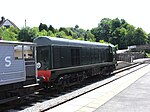 |
Class 20 Locomotive Society | Epping Ongar Railway |
| 20 007 | 20 007 | 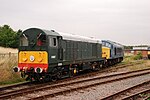 |
Class 20 189 Ltd | Mainline operational |
| 20 020 | 20 020 | 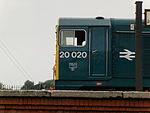 |
Scottish Railway Preservation Society | Bo'ness and Kinneil Railway |
| 20 031 | 20 031 |  |
Privately owned | Keighley & Worth Valley Railway |
| 20 048 | 20 048 | 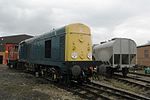 |
Class 20189 Ltd[22] | Midland Railway, Butterley
|
| 20 050 | D8000 | 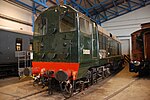 |
National Collection |
National Railway Museum |
| 20 057 | D8057 |  |
Privately Owned | Churnet Valley Railway |
| 20 059 | D8059 |  |
Somerset & Dorset Loco Company | Watercress Line |
| 20 069 | D8069 | 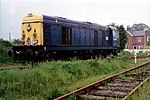 |
Privately owned | - |
| 20 098 | D8098 | 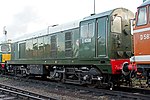 |
Type One Locomotive Company | Great Central Railway, Loughborough
|
| 20 137 | 20137 | 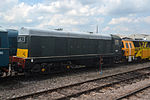 |
Privately owned | Gloucestershire Warwickshire Railway |
| 20 142 (Sir John Betjeman) | 20 142 |  |
Class 20 189 Ltd | Mainline operational |
| 20 154 | D8154 |  |
English Electric Preservation | Great Central Railway (Nottingham) |
| 20 166 | D8166 |  |
HNRC | Wensleydale Railway |
| 20 188 | D8188 |  |
Somerset & Dorset Loco Company | Watercress Line |
| 20 189 | 20 189 |  |
Class 20 189 Ltd | Mainline operational |
| 20 205 | 20 205 |  |
Class 20 Locomotive Society | Mainline operational |
| 20 214 | 20 214 |  |
Privately owned | Lakeside and Haverthwaite Railway |
| 20 227 | 20 227 |  |
Class 20 Locomotive Society | Mainline operational |
| 20 228 | 2004 |  |
Privately owned | Gloucestershire Warwickshire Railway |
A further three engines were preserved but later used for spares, then eventually scrapped. 20 035 was stripped of parts for use on fellow Gloucestershire Warwickshire Railway based classmate D8137, and later scrapped at EMR Kingsbury. 20 177 was located at the Severn Valley Railway and became a source of spare parts for D8188 & D8059; with the remains first going to C.F. Booth Ltd., Rotherham and then the cab section to The Cab Yard in south Wales.[23] 20206 was operated on the Mid-Norfolk Railway, but later sold by its owner, stripped of parts and scrapped.
Model railways
In 2008 Hornby Railways launched its first version of the BR Class 20 in OO gauge.[24]
In May 2021 Bachmann Collectors Club announced a limited edition run of two London Transport models of the class 20, No. 20142 Sir John Betjeman and No. 20227 Sherlock Holmes. The models are produced in conjunction with the London Transport Museum,[25]
Notes
References
- ^ a b c d e f g h i j k l m n o p Marsden & Fenn 1988, p. 71
- ^ Shipman, Mark (3 July 2004). "Class 20". Locomotive Photo Gallery. Archived from the original on 24 October 2004. Retrieved 30 December 2013.
- OCLC 49957965.
- ^ ISBN 0-85153-419-8.
- ^ "'At least 20 20s' for Barrow Hill diesel jubilee". The Railway Magazine. July 2007. p. 9.
- ^ a b c d e Wells, Monty (November 1982). "Tweak a Twenty". Railway Modeller. Vol. 33, no. 385. Seaton, Devon: Peco Publications & Publicity Ltd. pp. 398–401.
- ISBN 0-947773-02-9.
- ISBN 0-7110-0558-3.
- ^ "Pickersgill-Kaye sponsor Kosovo train for life". Pickersgill-Kaye Ltd. 27 September 1999. Archived from the original on 4 July 2008. Retrieved 20 May 2008.
- ^ "Class 20". The Railway Centre.com. Archived from the original on 27 September 2013. Retrieved 20 May 2008.
{{cite web}}: CS1 maint: unfit URL (link) - ^ "Train of life in Kosovo". BBC News. BBC. 25 September 1999. Retrieved 20 May 2008.
- ISBN 0-7110-0617-2.
- ^ a b Turner, Graham (2012). "Rail Blue - The Story". Rail Blue. Archived from the original on 24 July 2008. Retrieved 20 March 2008.
- ^ Turner, Graham. "The Class 20 Locomotive Fleet". Archived from the original on 21 November 2008. Retrieved 25 November 2008.
- ^ BR Telecommunications Ltd; Hallas, Sam; Ward, Chris. "BR Telecommunications Locomotives". samhallas.co.uk (Article). Archived from the original on 16 September 2013. Retrieved 30 December 2013.
- ^ Snook, William. The UK Railway Datafile 2015.
- ^ Department of the Environment (1973). "Railway Accident: Report on the Collision that occurred on 16th December 1971 at Lennon South Junction, Nottingham" (PDF). London: Her Majesty's Stationery Office – via Railways Archive.
- ^ "North Yorkshire Moors Railway collision: Passenger train and locomotive involved in accident at Grosmont Station". Yorkshire Post. Retrieved 21 September 2021.
- ^ "Collision at Grosmont". Rail Accident Investigation Branch. Retrieved 1 October 2021.
- ^ "Sinister Class 20 is new James Bond movie star". Rail. No. 250. 12 April 1995. p. 6.
- ^ "Class 20". Preserved Diesels. Archived from the original on 27 August 2008. Retrieved 15 August 2008.
- ^ "20048 sold to Class 20189 Ltd". Railways Illustrated. 24 February 2021.
- ^ "Collection – The Cab Yard". Archived from the original on 2 September 2018. Retrieved 9 December 2021.
- ^ "Hornby BR Class 20". Hornby Railways Collector Guide. Retrieved 1 February 2020.
- ^ "Limited Editions | Bachmann Collectors Club SOUND of the UNDERGROUND". BACHMANN EUROPE NEWS. 6 May 2021. Archived from the original on 6 May 2021. Retrieved 11 September 2021.
General references
- Marsden, Colin J. (1981). Motive power recognition: 1 Locomotives. Shepperton: Ian Allan Ltd. ISBN 0-7110-1109-5.
- Marsden, Colin J.; Fenn, Graham B. (1988). British Rail Main Line Diesel Locomotives. Sparkford: Haynes. OCLC 17916362.
Further reading
- Cole, Andrew (2016). Class 20 Locomotives. Amberley Publishing. OCLC 934603402.
- Dunn, Pip (26 February – 11 March 1997). "They'll always get you home!". RAIL. No. 299. EMAP Apex Publications. pp. 32–36. OCLC 49953699.
- Dunn, Pip (5–18 November 1997). "PDQ". RAIL. No. 317. EMAP Apex Publications. p. 37. OCLC 49953699.
- Dunn, Pip (11–24 February 1998). "Second batch of DRS '20s' nearly ready". RAIL. No. 324. EMAP Apex Publications. pp. 60–61. OCLC 49953699.
- Dunn, Pip (9–22 September 1998). "Enjoying the atmosphere of France '98!". RAIL. No. 339. EMAP Apex Publications. pp. 36–41. OCLC 49953699.
- Dunn, Pip; Loader, Martin (2003). Class 20 Photo File. Vanguard Publications. OCLC 867918624.
- Dunn, Pip (2016). British Rail Class 20 Locomotives. The Crowood Press UK. OCLC 930829335.
- Fell, Andrew (1994). Class 20s in Colour. Leicester: Midland Publishing Ltd. OCLC 31287783.
- Johnston, Howard (April 1983). "When Class 20s go on holiday". OCLC 49957965.
- McManus, Michael. Ultimate Allocations, British Railways Locomotives 1948 - 1968. Wirral. Michael McManus.
- "The 'new' Class 20/9 takes to the rails". RAIL. No. 93. EMAP National Publications. 6–19 April 1989. p. 8. OCLC 49953699.
- Oakley, Michael (1981). BR Class 20 Diesels. Truro: Bradford Barton. OCLC 16542512.
- "Outlines of Power No. 4: EE Type 1 (Class 20)". Rail Enthusiast. EMAP National Publications. February 1983. pp. 32–33. OCLC 49957965.
- Vaughan, John (1984). Profile of the class 20s. Poole: OPC. OCLC 13666530.
- Vehicle Diagram Book No. 100 for Main Line Diesel Locomotives (PDF). Derby: British Railways Board. October 1984. pp. 7–9, 34, 40–45 (per pdf) – via Barrowmore MRG.

